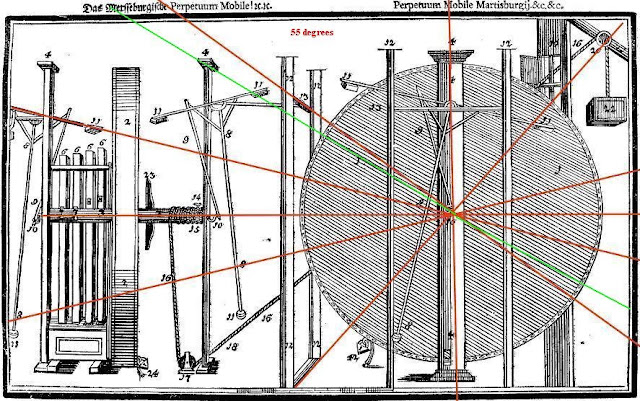In addition to his search for the solution to designing and building a perpetual motion machine Johann Bessler was also fascinated with the subjects of numbers, alphabets, alphanumerics and chronograms. This obsession might have been heightened by his visit to Prague where he learned about codes and ciphers.
He used his name to encode information about the number five and fifty-five. Potentially this clue pointed to the pentagram and/or chapter 55 of his second book Apologia Poetica(AP). This chapter is full of coded stuff which I go into more on my websites at www.theorffyreuscode.com and www.orffyreus.net
His first two illustrations, one in Grundlicher Bericht (GB) and another version in Das Triumphans…(DT) include a lot of numbered parts. Using just the numbers 1 - 24, he obtained a total of 660 which divided by 12 gives 55. Why divide by 12? Because Bessler cleverly embedded a clock in the same two drawings showing the 12 hours. This is the one from DT.
By drawing the lines of perspective within the illustration you can find a clock. This is confirmed by the eight o’clock line which includes two items numbered eight. Taking the 660 and dividing it by the clock’s twelve hours we obtain 55
His next illustration in DT was the Die Andere and Secunda Figua which was one illustration in two parts. He uses just the numbers from 1 - 10 which totals 55. Addingh all the numbers used on the left side totals 28, but those on the right add up to - you guessed it, 55!
Maybe by using Bessler’s favoured Caesar shift system, we find that ‘w’ is equivalent to the letter ‘j’, ‘j is the tenth letter. So why? I think it was a hint to read the alphabetic in this figure as both alphanumerics as well as the atbash. Any way the totals are as follows.
There are 39 numbers totalling 355. The letter ‘e’ is as usual missing from the left side, but that was how he highlighting the number. Adding the 5 to 355 to give 360, and brings the number total 40 - so 20 for each half. 360 divided by 20 equals 18, the basic pentagonal number, snd of course 360 divided by the missing 5 equals 72, one fifth of the pentagon.




